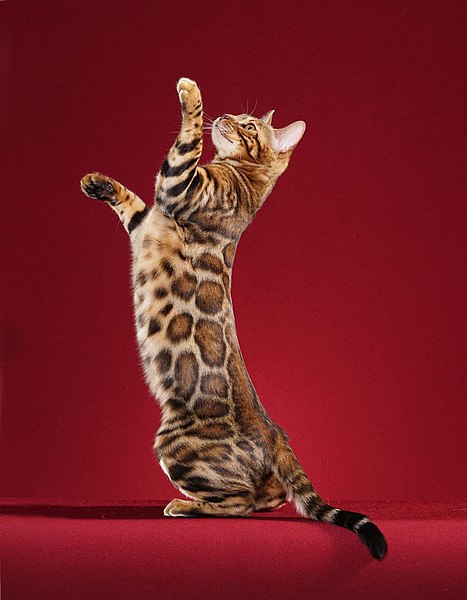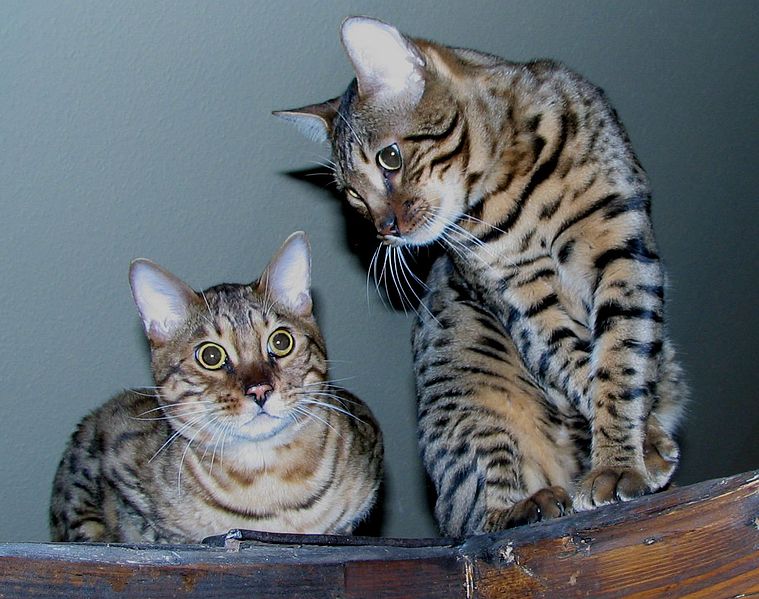Bengal cats are one of the most extraordinary cat breeds. But, along with their majestic appearance, there is a question: are they wild? Let’s go exploring.
True, Bengal cats are descended from the Asiatic leopard cat, ensuring their wild side remains intact. However, the level of their wildness is determined by their F or Filial number. Bengal cats with higher Filial scores have a wilder side.
Bengal Cats’ F ratings indicate the generation number. And Bengals from the F1 to F3 generations are thought to be closer to ALC characteristics, with F1 being the closest. As a result, they are wilder than those we see nowadays, belonging to F4 and up.
The following post will go into detail about whether Bengal cats are truly wild, as well as other facts about them. We will also discuss Bengal F scale ratings and how they affect their wild temperament.

Why are Bengal cats wild?
Bengal cats are one of the fascinating cat breeds. They are genetically related to both Asiatic leopard cats and domestic cats. But what makes them wild?
Bengal cats have a wild side due to the genetic disposition of the Asiatic leopard cat (ALC), or Prionailurus bengalensis. An ALC is a wild or jungle cat breed with all of the wild behavioral traits. In addition, Bengal cats have a wild side because of the wildness of one of their parents.
However, this breed should not be confused with pure wild cats. Bengals F4 and up are considered domestic cats. It is considered that from this generation, Bengal cats display dominant temperaments of domestic cats. However, if properly trained, they can make beautiful and loyal family pets. Along with their wild side, they also have a high IQ level.
What is an F1 Bengal cat?
To understand the factors influencing the temperament of modern Bengal cats, it is important to learn about the F1 Bengal cat. So what is an F1 Bengal Cat?
A hybrid cat is an F1 cat. In the context of Bengal cats, an F1 is a cross between an Asiatic leopard cat, or ALC, and a domestic cat (mostly mainly Bengal Cat). An F1 Bengal cat possesses both the ALC and the domestic (Bengal cat) breed traits. Yet F1 Bengal cats are often prohibited and regulated by the state due to their wild disposition.
One of the primary reasons for breeding F1 Bengal cats is to improve their overall appearance and characteristics. However, it is difficult to predict the actual temperament of the F1 Bengal cats. Furthermore, it is impossible to predict which parent will have a stronger influence on their progeny. Nonetheless, F1 Bengals frequently exhibit disruptive behavior linked with wild cats.
Bengal cats in F4 and later generations are deemed domestic cats.
Do Bengal cats act all the time wildly?
Bengal cats do, in fact, have a wild genetic side. It’s a hereditary gift from the ALC lineage. But do they always behave wildly?
It is incorrect to consider Bengal cats to be overtly wild. This breed doesn’t display wildness all the time. Furthermore, you can train them to behave like a typical house cat from a young age. They do, however, require mental and physical stimulation, without which they can become aggressive.
So, if you want to keep a Bengal cat as a pet, you must be able to meet their requirements. These cats are hyperactive, playful, and require constant attention. Try to accommodate their life needs if you don’t want their wild side to take over. In addition, we must keep in mind that Bengal cats are prone to misbehavior.
Are Bengal cats similar to small wild cat species?
Bengal cats are frequently regarded as wild cats due to their ALC ancestry. But are they similar to real wild cat species?
Modern Bengal cats are considered domestic breeds rather than wild cat species. Although they bear a striking resemblance to small leopards, they are not wild cats. Bengal cats simply have a wild appearance.
However, the status of F1, F2, and sometimes F3 generation Bengals is not the same. Adopting and breeding these cats is illegal. In addition, they are not considered domestic cats because they are descended from Asian leopard cats (especially the F1).
Can Bengal cats display wildness indoors?
Have you ever considered having a wild pet as a pet? It is the last thing anyone on the planet would want. Is it possible for Bengal cats to be wild indoors?
It is not a common trait in Bengals to exhibit wildness every time. However, it is critical to provide these cats with opportunities to expend their energy. And if you intend to keep your Bengal indoors but fail to stimulate it properly, it will exhibit its wild side even inside the house.
As a result, it is incorrect to assume that Bengals will go wild indoors every once in a while. Instead, how these cats behave will be determined by how you train them and accommodate their needs.
Modern Bengal cats are more on the domestic side than the wild side. However, we must keep in mind that they have an innate predatory instinct, which may manifest itself in the absence of a suitable environment for them to survive.
Under what circumstances can Bengal cats go wild?

If you want to get a Bengal cat as a pet, you should first learn about the conditions that can cause this breed to go wild. It would help you better manage your cat.
Absence of stimulation
Bengal cats must be kept mentally and physically stimulated at all times. They require opportunities to channel their energy. If they don’t get them, they’ll show their wild side by acting aggressively, spraying inappropriately, and so on.
Fear
Bengals are extremely territorial. As a result, if they are insecure about their territory, they will not mind displaying their aggressive side to defend it.
Sudden change in the environment
Cats, in general, dislike abrupt changes in their surroundings. Consistency is something they value. As a result, if you introduce a sudden change into your Bengal cat’s life, it may not be able to handle it properly and may throw tantrums.
Lack of training
Training is essential if you want to keep a Bengal cat as a pet. These cats are very intelligent and can learn tricks and discipline if properly trained. It is also critical to socialize them with other animals and humans. In this absence, they can exhibit their wild side whenever they meet a new individual or animal.
Can the wildness of Bengal cats be tamed?
Bengal cats can indeed go wild if they pick up problem behaviors. However, can you really tame wild or aggressive Bengal cats? Let’s explore.
Modern Bengal cats can be tamed down. Humans need to give time to their cats to calm themselves down. Spoil your Bengal with toys and regular mental and physical stimulation to eliminate any chance of getting them bored and picking up aggressive behavior.
That said, Bengal cats belonging to the F1 and F2 generations are usually not possible to be tamed. They are too wild to be tamed and kept as pets. From F4 onward, Bengal cats display a domestic temperament, and it is a lot easier to handle their wild and aggressive side.
Do Bengal cats get along with dogs?
Bengal cats are an extremely active cat breed. But, if properly trained, they can also walk on a leash and fetch like a dog. So, how do they get along with the dogs?
Bengal cats get along well with dogs. Bengals can particularly bond with dog species that are active and enjoy playing. Species such as the Beagle, Golden Retriever, and Labrador Retriever, among others, could make excellent playmates for the Bengals.
There’s something here. If there would be a bonding between a Bengal and a dog would also depend on if the dog is cat-friendly. Bengals are frequently reported to exhibit a dog-like temperament. So, if you have a friendly dog, you can enjoy the company of both.
However, a house with a Bengal cat and a dog would be very noisy and busy!
Do Bengal cats get along with cats?

It is not uncommon to see two or more cats living happily together. However, because Bengals have a wild side, do they get along with other cats or vice versa?
Despite their tendency to throw a tantrum, Bengal cats get along well with other cats. They can also be paired with another Bengal cat. This breed, on the other hand, is very territorial. So, before introducing a new cat, train your Bengal to respect its personal space. For example, teach them how to use their own litter box, eating bowl, and so on.
Some cat breeds that make great buddies with Bengals are Siamese, Abyssinian, Persian, etc.
Here are two things to consider if you want to keep a feline companion with your Bengal.
- Prepare your cat for the impending changes. Every cat appreciates consistency. The addition of a new buddy would require some changes to the existing one’s environment, which could be stressful.
- It is critical to teach cats to socialize with humans and other pets. Without this ability, it may be difficult for your cats to coexist peacefully. So, before introducing a new cat or kitten to your existing Bengal cat, teach it the skill of socialization.
Why would two Bengals may indulge in fights?
Bengal cats make excellent pets and get along well with other animals. However, you may occasionally witness a fight between two Bengals. But why would they go to fight?
Bengal cats are hyperactive, and boredom is one of the reasons they may bite or kick their feline friends. A Bengal may appear calm one moment and then start biting and kicking its companion the next. It occurs when one of them becomes bored or overexcited.
Such incidents are not uncommon for Bengal parents to witness. However, one can always keep toys nearby to keep the cats entertained and prevent these incidences from happening. Keeping an eye on Bengal cat overstimulation can also help to avoid fights.
Do Bengal cats get along with other smaller pets?
We must acknowledge that each cat has a distinct personality. Bengals are hyperactive, but they make excellent pets and get along well with most other animals.
Bengals, if properly trained, have the potential to be highly socialized. However, we should keep them away from smaller pets such as rabbits and hamsters. This cat breed has a strong prey drive and is extremely curious. As a result, entrusting them with smaller animals may be dangerous.
We’re not saying Bengals can’t get along with other small animals. However, their high prey drive allows them to attack smaller animals occasionally. Dog and cat breeds may be fine to keep with Bengals, but petite pets are not.
Are Bengal cats aggressive?
This is one of the most common questions from cat enthusiasts unfamiliar with Bengals. The breeds’ ALC lineage may prompt this question.
Bengal cats from F4 onwards have a strong influence from their domestic parent’s temperament. They aren’t particularly wild or aggressive. Nonetheless, in the absence of proper mental and physical stimulation, they are prone to picking up on problem behavior. Then we can see their aggression.
On the other hand, these cats can be properly trained to behave like any other domestic house cat. And it is not uncommon to come across Bengals who do not exhibit an intense wild temperament.
Do Bengal cats have an innate predatory instinct?
The predatory instinct is one of the main characteristics distinguishing Bengal cats from other domestic cats. This also causes cat lovers to doubt their suitability as house pets.
Bengal cats are born with a predatory instinct. They have a strong desire to hunt. These vivacious felines are extremely active and never stick to a single place. They also inherited a survival trait from their leopard forefathers: alertness.
In other words, Bengals are extremely powerful and can track and kill. As a result, if left unattended, they may endanger smaller pets. Bengals also enjoy the water. So they may become overly interested in it and the fish inside if an aquarium is nearby.
Is Bengal cats’ wildness influence their hyperactivity?
Cats and kittens, in most cases, spend the majority of their time sleeping and being couch potatoes. Bengals, on the other hand, have an entirely different temperament. They are extremely active.
Bengals are hyperactive, and their wild ancestors, the ALC, are responsible for most of their temperament. Although modern Bengal cats are the farthest from ALC genes, they are not entirely devoid of them. Bengals, like predators, will need to expend their energy through rigorous physical activity more than other domestic cat varieties.
Furthermore, their high IQ contributed to their hyperactive personality. They are astute and skilled hunters, and when these two characteristics combine, they become walking recipes for mishaps.
The level of hyperactivity varies in Bengals. But the whole hyperactive traits are prevalent in almost all Bengal cats. And sometimes, their hyperactivity can make them a less desirable cat breed to domesticate.
Can Bengal cats be indoor cats?
Cats, unlike dogs, are not meant to be cooped up indoors. Nonetheless, we frequently come across indoor cats. But, given their high energy level, can Bengals be kept as indoor cats?
Bengal cats can be kept as indoor cats if they have plenty of room to run and play. However, they would also require many toys to keep themselves entertained. The general rule is that your Bengal should never be bored because it is then that they begin to exhibit problem behaviors such as aggression and inappropriate spraying.
On the other hand, allowing your cat to go outside for a few hours every day is always good. Bengals can be taught to walk with a leash. So you can take it for walks and let it play outside to burn off some energy.
Summary
To summarize, we can say that the Bengal has a wild side. However, they are not wild cats. The International Cat Association recognizes modern Bengals as a domestic cat breed. However, if you decide to get one, make sure to consider your cat’s needs, which can be unique and different from those of average domestic cat breeds. Bengals can become loving house pets with love, the right environment, and training.




